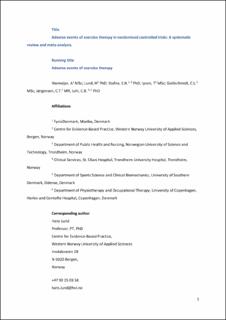| dc.contributor.author | Niemeijer, Andre | |
| dc.contributor.author | Lund, Hans | |
| dc.contributor.author | Stafne, Signe Nilssen | |
| dc.contributor.author | Ipsen, Thomas | |
| dc.contributor.author | Goldschmidt, Cathrine Luhaäär | |
| dc.contributor.author | Jørgensen, Claus Thomas | |
| dc.contributor.author | Juhl, Carsten B. | |
| dc.date.accessioned | 2020-03-13T12:05:38Z | |
| dc.date.available | 2020-03-13T12:05:38Z | |
| dc.date.created | 2019-10-22T12:38:23Z | |
| dc.date.issued | 2019 | |
| dc.identifier.citation | Niemeijer, A., Lund, H., Stafne, S. N., Ipsen, T., Goldschmidt, C. L., Jørgensen, C. T. & Juhl, C. B. (2019). Adverse events of exercise therapy in randomised controlled trials: a systematic review and meta-analysis. British Journal of Sports Medicine. | en_US |
| dc.identifier.issn | 0306-3674 | |
| dc.identifier.uri | https://hdl.handle.net/11250/2646729 | |
| dc.description | Author's accepted manuscript (postprint). | en_US |
| dc.description.abstract | Objective To evaluate the relative risk (RR) of serious and non-serious adverse events in patients treated with exercise therapy compared with those in a non-exercising control group.
Design Systematic review and meta-analysis.
Data sources Primary studies were identified based on The Cochrane Database of Systematic Reviews investigating the effect of exercise therapy.
Eligibility criteria At least two of the authors independently evaluated all identified reviews and primary studies. Randomised controlled trials were included if they compared any exercise therapy intervention with a non-exercising control. Two authors independently extracted data. The RR of serious and non-serious adverse events was estimated separately.
Results 180 Cochrane reviews were included and from these, 773 primary studies were identified. Of these, 378 studies (n=38 368 participants) reported serious adverse events and 375 studies (n=38 517 participants) reported non-serious adverse events. We found no increase in risk of serious adverse events (RR=0.96 (95%CI 0.90 to 1.02, I2: 0.0%) due to exercise therapy. There was, however, an increase in non-serious adverse events (RR=1.19 (95%CI 1.09 to 1.30, I2: 0.0%). The number needed to treat for an additional harmful outcome for non-serious adverse events was 6 [95%CI 4 to 11).
Conclusion Participating in an exercise intervention increased the relative risk of non-serious adverse events, but not of serious adverse events. Exercise therapy may therefore be recommended as a relatively safe intervention. | en_US |
| dc.language.iso | eng | en_US |
| dc.publisher | BMJ Publishing Group | en_US |
| dc.title | Adverse events of exercise therapy in randomised controlled trials: A systematic review and meta-analysis | en_US |
| dc.type | Peer reviewed | en_US |
| dc.type | Journal article | en_US |
| dc.description.version | acceptedVersion | en_US |
| dc.rights.holder | © Author(s) (or their employer(s)) 2019. | en_US |
| dc.source.journal | British Journal of Sports Medicine | en_US |
| dc.identifier.doi | 10.1136/bjsports-2018-100461 | |
| dc.identifier.cristin | 1739498 | |
| cristin.ispublished | true | |
| cristin.fulltext | postprint | |
| cristin.qualitycode | 2 | |
